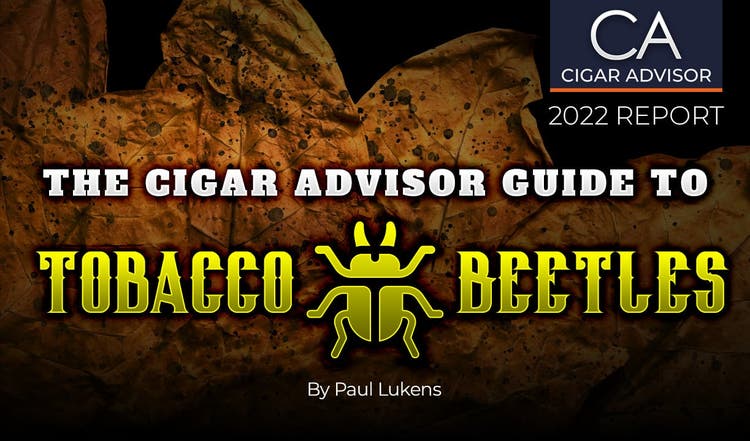
The Cigar Advisor Guide to Tobacco Beetles
Meet the Beetles – What You Need to Know About Cigar Beetles
Lasioderma serricorne, commonly known as the cigar or tobacco beetle, is the dreaded scourge of cigar enthusiasts everywhere. Left unchecked, an invasion of these tiny and insatiable pests can render your collection of prized premium cigars to an un-smokeable stockpile of expensive trash.

To summarize a common piece of folk wisdom, prevention beats the cure. And the best way to deal with cigar beetles is to prevent them from the get-go. In this guide, we’ll talk about tobacco beetle prevention along with pro tips on what do if your cigars become affected.
If you’ve got a tobacco beetle tip you’d like to share, please leave it in the comments below!
How to Prevent Cigar Beetles

Here’s an unsettling thought—at this very moment there could be an army of tobacco beetle eggs sitting dormant in your cigar collection. They could be in one cigar or all your cigars, just waiting to hatch. Or there could be none.
Once hatched, cigar beetles don’t discriminate. They will seek and destroy without prejudice—whether an assortment of finely aged Fuente’s in a high rent humidor or a bounty of bundled budget blends in a Tupperdore. In fact, their journey began long before the tobacco leaves—where they started off as eggs—were crafted into the premium cigars in your possession.
Barely visible to the naked eye, cigar beetle females lay their eggs while the tobacco leaves are still in the fields. Despite the many quality control checks along the way—and due to the nearly microscopic size—cigar beetle eggs often find their way to the end product. The good news is that at this stage, they’re harmless.
The danger zone occurs when the humidity level reaches 72% (and above). These are the conditions when tobacco beetles begin to hatch. Then multiply. To prevent this from happening, keep your humidor under 70% humidity—ideally in the 65-67% range (at this point, it comes down to personal preference). Additional things to consider are moving your humidor to a cooler location during the warmer months and keeping an eye out for the early signs of a potential tobacco beetle infestation—tiny pinholes on your cigars or tobacco dust in your humidor.
How to Eradicate Tobacco Beetles

Ok, don’t panic. Despite your best efforts, you’ve got unwanted guests—but all hope isn’t lost. There’s still time to save your treasured cigar collection.
First, you need to identify—by tiny pinholes in cigar wrappers and tobacco dust coming from the foot—and isolate the sick cigars. Then, and this is the hard part, throw away the cigar beetle infested sticks. They aren’t salvageable and are beyond hope. At this point, I wouldn’t blame you for pausing for a moment of silence for the fallen or ‘pouring one out for the homies.’
Now to save those handmades still standing in your humidor. The enemy of cigar beetles is the cold, so the challenge is to freeze your cigars without damaging them. If you rush the process, you risk your cigars swelling and cracking. The best way is slow and easy—and with protection.
Begin by putting the remainder of your cigars in an airtight bag—like a Ziploc® freezer (or generic equivalent). You’ll want to use the smallest size that will accommodate your collection. Squeeze out any air and seal the bag before placing it in your refrigerator for 4 hours. Remember, slow and easy. From here, you put the bag(s) into the freezer for a minimum of 8 hours. But why rush, it’s recommended to keep your cigars in the freezer for 24-36 hours to make sure all the beetles are dead. But you’re not done yet—while cold kills tobacco beetles, rapid fluctuations in temperature and humidity can do the same to premium handmade cigars—from the freezer place the bag(s) back into the refrigerator for a few hours. Finally, bring your cigars to room temperature.
Before reintroducing your remedied cigars back in your humidor, you’ll want to make sure the environment is clean and clear of tobacco beetles.
After the Beetles

Clean out the humidor by vacuuming (or shaking) out any debris and dust. Next, dampen a clean cloth with distilled water and wipe down the interior. Now, you can finally return your cigars back home.
Remember, prevention is the key. By keeping things cool in your humidor (with a humidity level ideally maintained around 65-67%) and watching for signs of early trouble you can prevent a full-blown tobacco beetle revolution and cigar collection carnage.